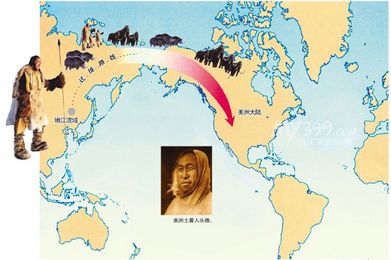(单词翻译:单击)
听力文本
This is Scientific American — 60-Second Science. I'm Emily Schwing.
For more than ten thousand years, Alaska Native and Canadian First Nations people have lived along the Northwest coast of North America. Now, ancient remains have provided genetic proof of that long habitation.
"There's largely the same gene pool in northern northwest North America today that there was ten thousand years ago."
Ripan Malhi at the University of Illinois–Champaign. He and colleagues analyzed the DNA in four skeletons found in the region that range from 1,500 to 10,000 years old. And the results have two major implications. First, they support traditional oral histories about life in the region. Second, they open up the possibility for new theories about how people migrated to the continent—namely, more than one colonization.
"It could be that folks first moved south into Central and South America and then back up into North America, or it could be that there was another movement from northeast Asia into North America later on in time. So, there are many different possibilities that could explain the patterns that we are seeing."
The study is in the Proceedings of the National Academy of Sciences.

The researchers also compared genetic data from Northwest coast populations with DNA in remains unearthed south of the Canadian border. The analysis shows that the almost 13,000 year old Anzick Child found in Montana is related more closely to people from Central and South America than to Washington state's 9,000-year-old Kennewick Man, who is of entirely different lineage. He is not related to people of the Northwest Coast, and his genes aren't all that closely linked to Anzick Child's South American relatives either. Which shows that the story of the settlement of the Western Hemisphere is still very much a work in progress.
Thanks for listening the Scientific American — 60-Second Science Science. I'm Emily Schwing.
参考译文
这里是科学美国人——60秒科学。我是埃米莉·施温。
一万多年以来,阿拉斯加原住民和加拿大原住民一直生活在北美洲西北海岸。现在,古代遗迹为原住民的长久居住提供了遗传学证据。
“如今,北美西北面北部地区的基因库与一万年前的基本相同。”
伊利诺伊大学香槟分校的里潘·马尔西说道。他和同事对这一地区发现的四具骸骨中的DNA进行了分析,这些骸骨距今1500年到10000年不等。研究结果有两个重要意义。首先,研究结果支持该地区流传的有关当地生活的口述历史。第二,研究结果为人类如何迁移到美洲大陆的新理论提供了可能性,新理论认为人类不止进行了一次殖民活动。
“可能是人类先向南迁移进入中南美洲,然后他们又返回北美洲,也可能是一段时间之后人类又进行了一次从东北亚到北美的迁移。所以,有许多不同的可能性可以解释我们现在所看到的模式。”
这项研究结果发表在《美国国家科学院院刊》上。
研究人员还将西北海岸居民的基因数据与在加拿大边境以南挖掘出的遗骸中的DNA做了对比。分析结果显示,在蒙大拿州发现的近13000年前的安吉克小孩与中南美洲人关系更近,与华盛顿州9000年前的肯纳威克人关系较远,肯纳威克人拥有完全不同的血统。肯纳威克人与西北海岸居民没有关系,他们的基因与安吉克小孩南美亲戚的联系也不太紧密。这表明,西半球的迁移活动仍在进行之中。
谢谢大家收听科学美国人——60秒科学。我是埃米莉·施温。
译文为可可英语翻译,未经授权请勿转载!
重点讲解
重点讲解:
1. open up (使)(机会、可能性等)出现;(使)产生;
例句:It was also felt that the collapse of the system opened up new possibilities.
人们也认为这一制度的崩溃带来了各种新的可能性。
2. later on 以后;稍后;
例句:I shall explain that later on.
这一点我后面再作说明。
3. compare with 比较;对比;
例句:Let's compare the translation with the original.
让我们把译文和原文比较一下。
4. in progress 正在进行中;
例句:The road construction work is in progress.
筑路工程正在进行中。


